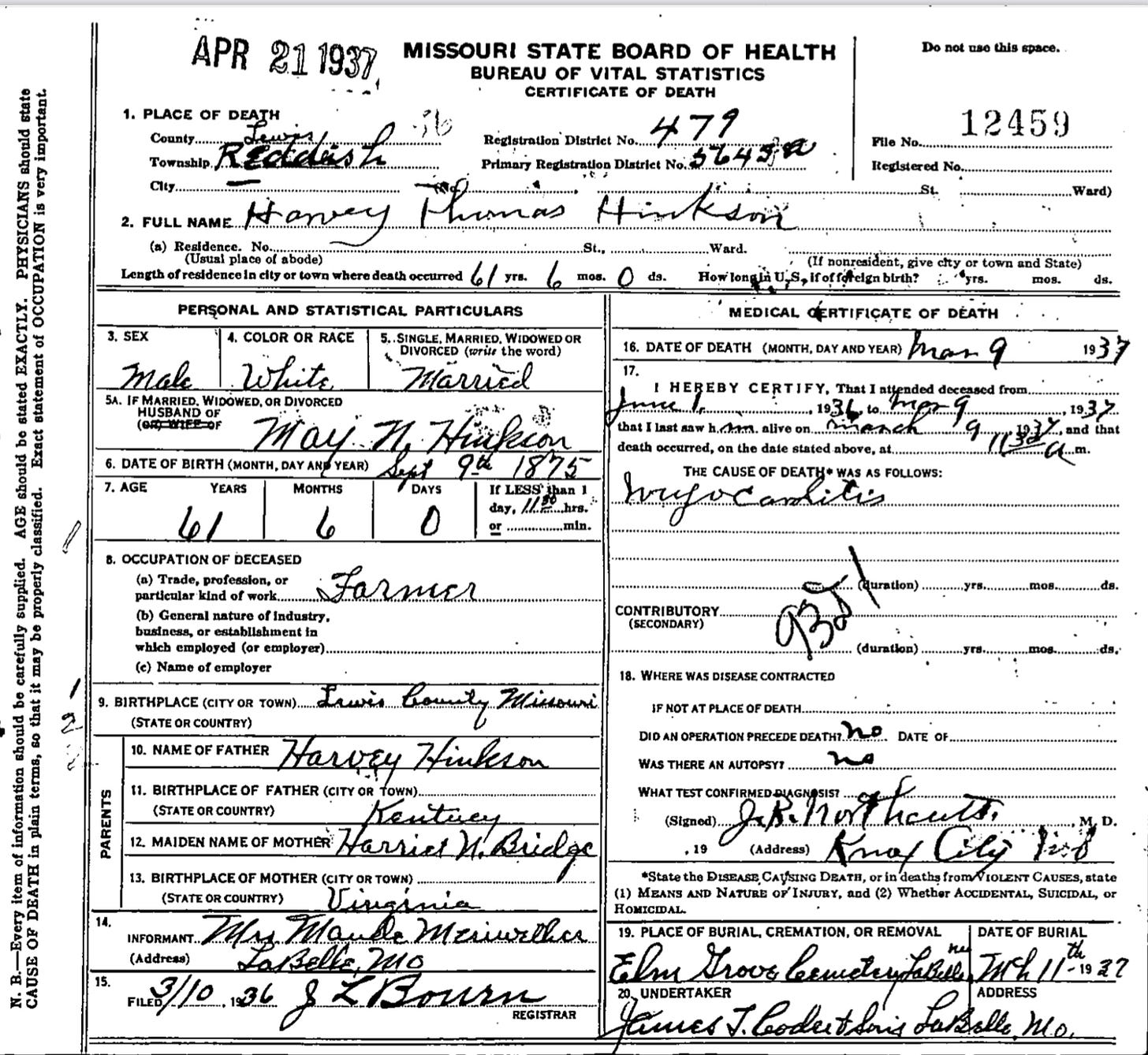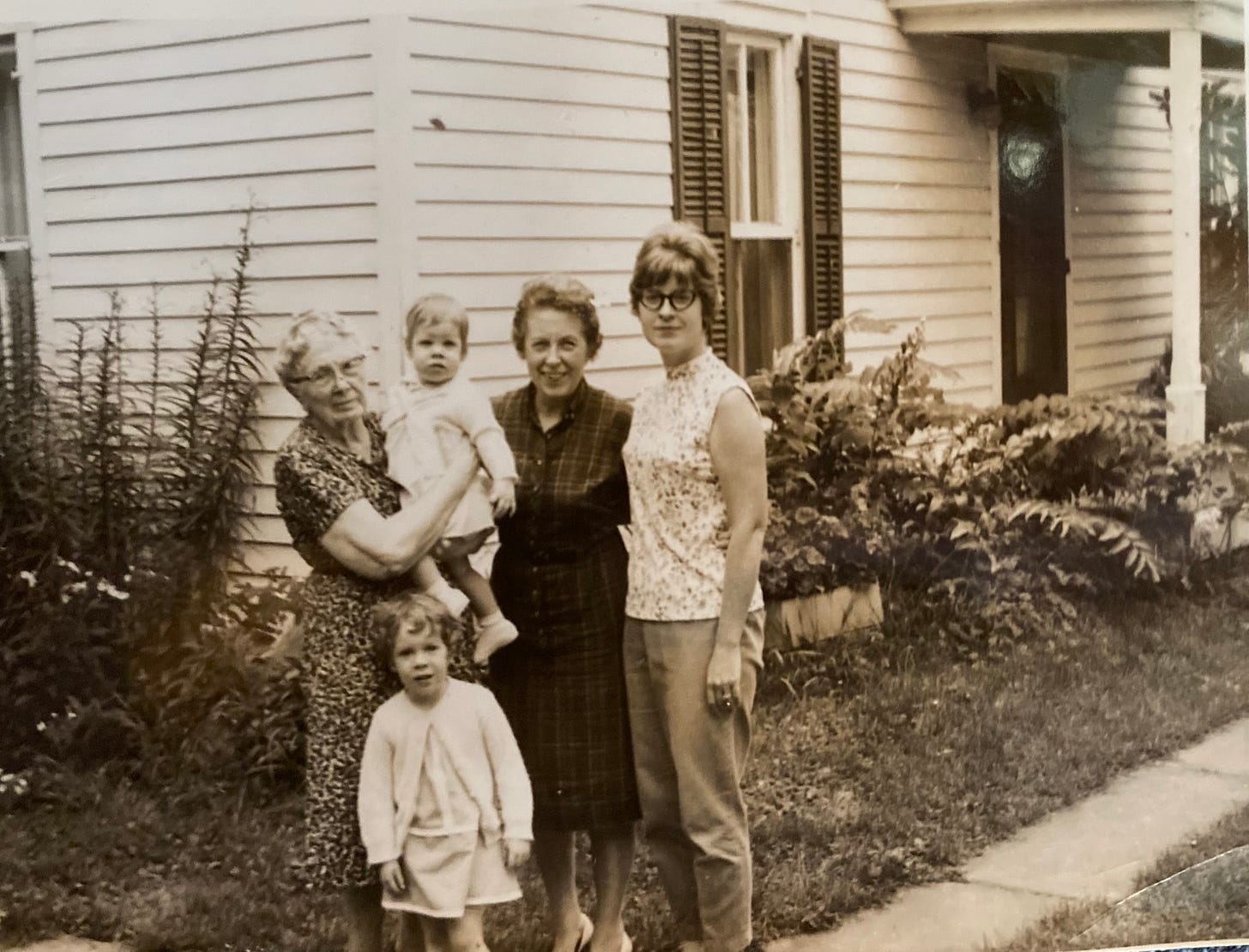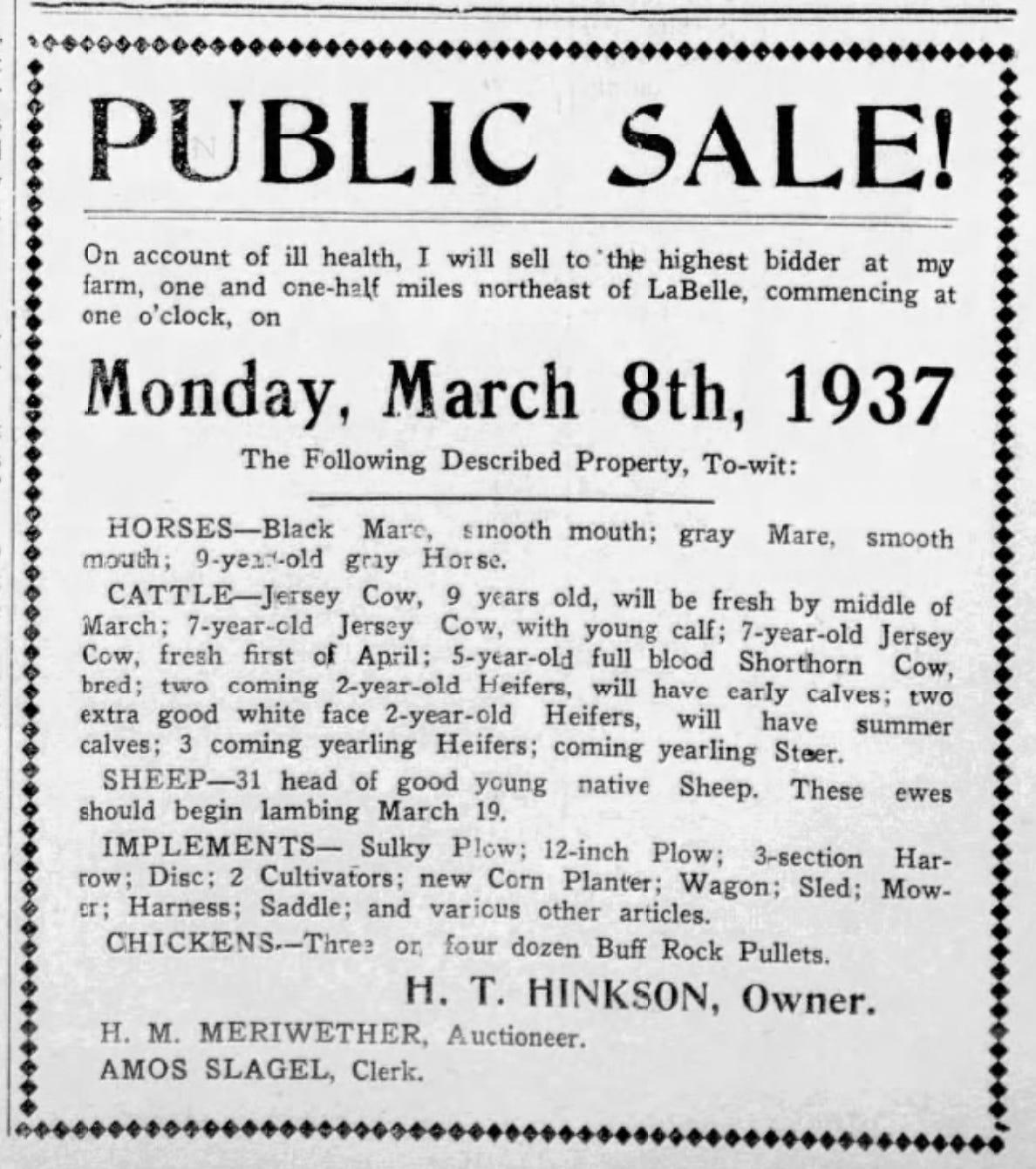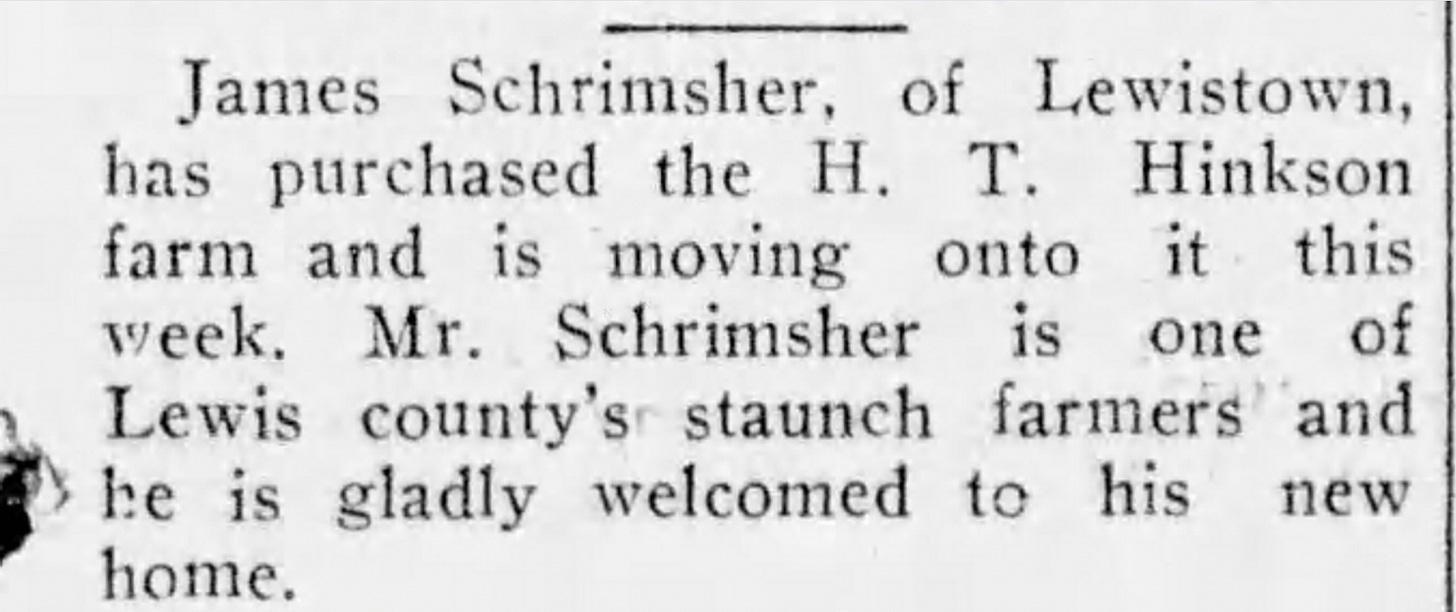Letter #15, postmark May 29, 1961, addressed Mrs. Douglas Green, East Lansing, MI
Monday 9:15 AM
Dear Greens,
I hope your day is as pretty as the one in LaBelle – all we need to make it perfect is a few showers. Most gardens were worked when they were too wet so the clods are bothering. I just came in from scratching in the lima row with my fingers to help some of the cotyledons* get through. Your father knew just how to crack the rows with a hoe, and the grateful peas and beans would pop right up. I also dug up a little place to set out some Bells of Ireland I brought over from Mrs. North’s. I planted some, but I can’t remember where – the same is true of the tube roses. I suppose they’ll surprise me if I don’t pull them up as weeds. As soon as I finish this and comb my hair I’m going to town to see what I can find in the way of flowers. I’m going to settle for artificial ones – except two or three stalles of red glads. I hope I can get there to brighten up the pale yellow iris I have. When I reset my (flower) bed, I made a poor guess – it practically all turned out one kind. Mrs. North came over and took the leaving and got a nice variety – one that had never bloomed for me.
I feel much calmer inwardly this morning after making my decision not to go to Colorado and putting it down in writing. It isn’t due to the little sweet children, but I just don’t feel up to sightseeing for a week and dragging things in and out a suitcase each day. Maybe trips – not visits are over for me, we shall see – maybe it’s because my little friendly house is just too comfortable and pleasant to leave. It really is a sanctuary. I can hardly wait for the Greens to stop over – it will be a nice break between the rush of the school terms and the different work of the summer. I’ll miss Virginia’s visit, but I can’t complain – she comes far every year to see me – all her life she has gotten homesick and I know she will be disappointed – that disappointing her was all that ever made me consider going for one minute.
I love all of you – Mother [May Emma Northcutt Hinkson]
* cotyledon = the first embryonic leaf on a seed-bearing plant
My great-grandmother’s “little friendly house” held a place of special reverence in my family. It wasn’t a striking home, a beautiful mansion, or any place that would cause you to look twice as you drove by. In fact, on the outside, it was pretty nondescript and bland, but once you stepped inside, you couldn’t help but feel the love.
The purchase of the house was a somewhat anticipated, yet unexpected event that occurred during what I can easily guess was the most difficult year of May’s life. In 1937, she broke her right arm slipping on ice, and spent nearly all her free time tending to her husband’s extended illness, only to lose him in early March while the family was in the process of selling the family farm.
Harvey Thomas Hinkson was a hard-working and godly man known as “Tom” by his family and locals. He farmed and raised livestock on the land that his father had settled just north of LaBelle in the late 1850s and raised his family on the property in two different homes. The first had been built by his father. The second had been built by Tom and May a mere ten years into their marriage when the original family home burned to the ground in the fall of 1914. For more than 34 years, the property had been more than just home to May and Tom; it provided a means for their livelihood, an income for the family, and a healthy environment to raise their three children. So I can imagine there were lots of anguished conversations at the dinner table (or perhaps the bedside and chair) over the family’s predicament in the fall of 1936 and winter of 1937 when May and Tom made the decision that they needed to sell the family farm and relocate into town - on account of Tom’s continued failing health.
Although Tom’s death had been anticipated due to the length and severity of his extended illness, the timing could not have been worse for May, who was already overwhelmed with tasks associated with selling the family farm and relocating into town. Many in the LaBelle community were well aware of Tom’s declining health as a sale of personal belongings had been announced the week before. The planned sale actually occurred on a Monday, the day before Tom’s death - which according to ‘community activity reports’ in the LaBelle Star, was well attended.
The unexpected timing of his death is most likely the reason that two notices for Tom Hinkson’s death were published in the LaBelle Star (published weekly). The first on March 12, provided only a very brief notice. The second, published a week later, provided a more fitting obituary - most likely written by my great-grandmother. Tom’s death certificate indicated he died of myocarditis, an inflammation of the heart, with an illness period spanning nine months (June 1, 1936- March 9, 1937). It was signed by his attending physician and father-in-law, Dr. J.R. Northcutt.
TOM HINKSON DEAD
Following months of ill health, Thomas Hinkson, living north of LaBelle, passed away Tuesday. A sale of personal property was held at his farm and arrangements had been made to move to LaBelle, when death intervened. Funeral services were held Thursday (yesterday) at 2 o’clock.
The LaBelle Star, March 12, 1937, page 1
THE PASSING OF A USEFUL, UNSELFISH MAN
Services held in Christian Church Thursday – internment was in LaBelle Cemetery
Harvey Thomas Hinkson, son of Harvey and Harriet Bridge Hinkson was born September 9, 1875, on the farm northeast of LaBelle. He died March 9, age 61 years and six months.
Here in this community, he spent a happy childhood, a glorious youth and a manhood of usefulness, integrity and service.
At the age of 13 he became a member of the LaBelle Christian Church, and faithfully and well he served his master and the church as Deacon and Elder.
He was married in 1903 to May Emma Northcutt and to them were born three children. – Robert Northcutt Hinkson, Harriet Virginia, Hinkson, and Helen Lee Hinkson.
His going is an irreparable loss to these, and to his dear daughter-in-law, Marie Bruns Hinkson; his dear son-in-law, Douglas Green; His dear sister and brother, Mrs. Maud Merriweather and Ernest Hinkson; his nieces, nephews, other relatives and friends.
Much could be written concerning his respect and affection for his fellow man, his beautiful and unselfish devotion to his family, his reverence for his God and all the beauties of nature; his exemplification at all times of that which was true and upright and good, but a life, such as his needs no eulogy. It speaks for itself.
Funeral services were held in the Christian Church Thursday afternoon, conducted by Reverend J.H. Coil, a former pastor, and interment was in LaBelle cemetery.
The LaBelle Star, March 19, 1937, page 1

Even with months of declining illness to help May prepare for the inevitable, Tom’s death I’m sure was still a huge blow. Fortunately, for her, she had resumed teaching school before her children had grown and left home, so she had a small income to sustain herself. At the time of Tom’s death, she was a teacher at the Sharpe school (a rural one-room schoolhouse just north of LaBelle); a career that she enjoyed and found very rewarding… and one that I imagined also helped her to keep moving forward in the wake of her husband’s death.
I’m not sure where May stayed immediately following the sale of the family homestead. Did she stay on the farm for a while or find somewhere else to live temporarily? I suspect she may have stayed with friends so that she was close enough to the Sharpe school for the completion of the remaining term or relocated temporarily to her Knox City childhood home, a mere five miles away.
The sale of the family home was most likely already in the works at the time of Tom’s death for a noticed appeared in the newspaper just a week after Tom’s death. From what I can find through my LaBelle Star research, it looks like May didn’t purchase the “little friendly house” until July of the same year - three months after her husband’s death and a month before she began a new teaching assignment in the Knox City schools.
Mrs. Mae Hinkson has purchased the residence property of the late Miss Flora Mohfeldt from Miss Alice Bourn, who will sell the personal property on August 4 at 2 o’clock. Miss Bourn, who has been making her home for some time to be with her sister, will return to, Oklahoma City after the sale.
The LaBelle Star, July 30, 1937, page 5
As a child, I remember the “little friendly house” as the place I spent two weeks at every summer after riding a full day (~550 miles from our home in northern Wisconsin) in the backseat of the family sedan with the windows rolled down. We always seemed to visit in the heat of the summer and our car, like most in the 1960s, did not have air conditioning.
The two things that stood out to me the most about the “little friendly house” were its unusual layout (at least to me) and the side porch swing - where my siblings and I would spend hours rocking away on as we played imaginary games, like “train”. One of us kids would be the ‘conductor’, stopping and starting the train/swing to deliver the others (aka the passengers) to new and imaginary stops and locations.

Even as a young child of ten and eleven, the home’s layout struck me as being unique. But as I now reflect, some 50+ years later, I realize that the small home was most likely built without the comforts of central heat. As a result, the unusual layout may have been on purpose and a nod to a time when basic needs and function trumped fashion and form. I feel pretty sure in stating that the home when originally built, had neither running water nor indoor toilet facilities, as there was still an external working well pump in the side yard and the remnants of an old outhouse beyond the backyard garden.
The dining room served as the home’s center with the doors to all the other rooms directly accessible around its perimeter. In the corner near the south window sat a small propane heater that I think may have been the only heating mechanism for the whole home. To the west side you could access two bedrooms, and to the east a side porch. Along the north side of the room was a large oversized walk-in closet that served as a divider to the home’s front hallway and front door. A small sitting room hung off the northeast side divided by a tasseled heavy curtail that I believe was pulled closed during cooler weather - though I never visited in the winter to see it for myself. And finally to the south side of the dining room was the door to the kitchen, which was also connected to the most ‘used room’ during our visits every summer - the side porch. The home did not have air conditioning, so this was where we spent most of our time occasionally encountering a nice Missouri summer breeze. If no breeze was present, there were plenty of Coder funeral cardboard and woven church palm frond fans hanging around to encourage us to stir up the air for ourselves.
The small structure had an obvious home addition that had been added some years later. It included a long hallway off the back kitchen. Along this corridor the space was divided into several small basic functions and/or rooms; a bathroom, a storage pantry for home-canned goods, and a sewing nook containing my great-grandmother's antique treadle foot peddle sewing machine. At the very back of the hallway was a corner for a small daybed that served as May’s favorite napping spot. She also used it as her nightly sleeping spot whenever she unselfishly gave up her bedroom to visitors. And, although the bathroom did have running water, the home did not have a hot water heater. So our baths were run with the addition of pots of boiling water heated up on the stove to help achieve a lukewarm temperature palatable enough for us to get in a quick ‘tub scrub’.
In the center of the dining room was a large table with plenty of chairs to serve company and friends. Big dinners were always served at the table and there was always room for the additional friends and neighbors who stopped by frequently. When it rained outside, the table was often captured by us kids as “our fort” with the chairs covered by sheets and assorted quilts. If we weren’t under the table we were on top of it coloring away on the unblemished pages of old coloring books. The dining room's oversized closet was a treasure trove of old games that had been played by our mother as a kid, coloring books from bygone days, and abandoned craft supplies. It was all great fodder for us ‘youngsters’ to keep ourselves occupied and out of the adults’ hair.
As a child, I don’t recall ever hearing the phrase “little friendly house” whenever we visited LaBelle. But it’s very clear from how often I’ve already encountered it in May’s letters (I’m currently only at letter 66, August 1961) that these three words were more than just a pet phrase; they truly held deep and personal meaning to my great-grandmother. To illustrate this point, here’s a short comment from a recent letter I just read the other day, that I think expresses the sentiment she felt best:
I just went in to get this dictionary – my living room to me is so pretty – all of this little friendly house is so dear to me. It has always just seemed to throw its arms around me. How poetic and maudlin can one get! - Letter # 52, May 23, 1962
My earlier question about the timing of my great-grandmother’s move after her husband’s death was answered in another letter that I recently read. It’s clear that a lot happened fast the week that Tom died. In the span of just one week, she lost her husband, her home, and the foundation that comprised thirty-four years of her life as a married woman. I can’t imagine how she survived all this loss so eloquently, but I would guess that she leaned heavily on both her faith and ability to work. In reading her letters to date it’s also very apparent that her approach to life (which focused greatly on gratitude) not only got her through 1937 but also sustained her for the next thirty-eight years of her life in the “little friendly house.” The letter below wonderfully encapsulates this ‘life philosophy’ and also provides something that I have not often encountered in my great-grandmother’s letters…. a rare moment of reflection and honesty about how it feels to lose your life’s partner and live out your life solo.
Letter #42, postmark March 12, 1962, addressed Mrs. Douglas Green, East Lansing, MI
Monday morning
Dear Helen and Penny,
Next week, I’ll be back to dear Green girls? When Jenny has again come to the pleasant house at 319 Center St. Just yesterday, it seems I saw that car loaded and driven off in the cold. And cold we still have, but snow, as such as gone – water water everywhere. Just 25 years ago today I moved to Labelle. I daily and reverently, thank God for the health, strength, ability, and “mind to work“ so that they have been full years and good years, if at times, almost unbearably lonesome, not lonely, years. I hope you distinguish the difference between lonesome and lonely – never lonely except for a few hours every Sunday afternoon – from three to six my life long, and that is plain stupid. Jeanette relieved the tension, boredom or what have you a bit yesterday. She is feeling better but hasn’t yet accepted the “from here on” slogan but she has decided it is not teaching she will be objecting to so strongly but teaching in a place where she lives in the country and drives over country roads. She had enjoyed her little visit at Sally’s and thought the baby was just too sweet…
I’ll run to mail these before dinner and this afternoon will be mine.
I love everybody. Mother.
ADDENDUM:
In looking back through the record of my dictated letter readings, I came across this earlier letter where May also nodded to the empty feelings that dodged her throughout her life on Sundays.
Letter #25. Postmark October 16, 1961 addressed to Mrs. Douglas Green, East Lansing, Michigan.
Sunday night
Dear Greens,
After our phoning Sundays, I feel we’ve said most of what has been happening and I write the other letters first but tonight, I’m anxious to continue our conversation while the burner is high. Jenny, your expression of “cooking on the low burner“ is a new one to me and so expressive – only I attribute that low on Sunday evening simply to the day and the hour. All my life I’ve had it. I can actually look back on special Sundays when the burner was a special low – well this one is about over for me and an hour more nearly over for you. Maybe you did too much cheering for the Spartans or do you have to repress your cheers for when your host is rooting for the other side? I’m glad you are having such a good time this fall – make the best of it. You may get stuck with a bad job next term. Asked to teach someplace much near home…










This is just beautiful storytelling! Thanks for sharing it and reminding me of countless hours of playing train conductor on a very different porch swing.